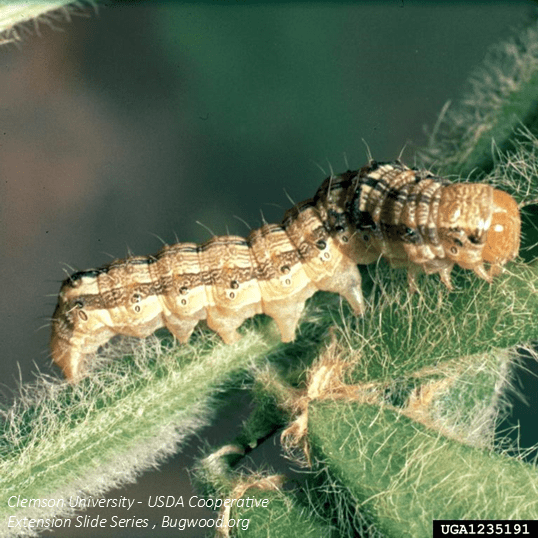Emily Zobel, Senior Agriculture Agent Associate | ezobel@umd.edu
University of Maryland Extension, Dorchester County

It’s time to start scouting for podworms (Helicoverpa zea) in double-crop soybeans. There have been reports of high numbers of small and young pod worms and soybean loopers in double-crop soybean on the Delmarva. Podworms prefer fields that are flowering, open canopy, and stressed and have been recently sprayed with a non-selective insecticide. Their population can be spotty, so one field can be high while the field next to it is low, so the only way to know what is happening in a particular field is to sample it. You can sample for podworms using either a sweep net or drop cloth.
- If you are using a shake cloth, using a two foot cloth, bend the plants over the cloth and shake them vigorously at each sample site. Note the number and size of larvae in a four-foot sample area at each site.
- If you are using a sweep net, be sure to angle the net opening upward as you sweep the upper 2/3 of the soybean plants in an upward motion. Each pass is considered a sweep. Do 25 sweeps per location at several locations in a field.
- In soybean where neither sampling method can be used, treatment of the podworm is recommended if 5-10% or more of the soybean pods exhibit feeding damage from podworm larvae.
If most of your caterpillars are soybean loopers or other caterpillars, then following the general defoliation threshold for soybeans, of 30% defoliation throughout the plant canopy two weeks before blooming (R1) and 15% defoliation throughout the plant canopy two weeks after flowering (stage varies) until the pods have filled (R7-R8).
Treatment is recommended for podworm when counts exceed 3 medium to large podworms per 25 sweeps in narrow row fields or 5 podworms per 25 sweeps in wide row fields (20 inches or greater). The timing strategy is to wait until most of the larvae are 3/8 inch or more in length, and then treat when pod damage is first evident. This allows for most egg laying and hatching to occur before treatment and reduces the chances of a second spray being needed later. These static thresholds are based on long-term averages for control costs and soybean prices.
North Carolina State Extension has developed a dynamic online threshold calculator for podworm in soybeans that takes into account the sampling, row spacing, cost for control, and the value of soybeans, which can be found at: https://www.ces.ncsu.edu/wp-content/uploads/2017/08/CEW-calculator-v0.006.html.
Always read and follow the pesticide label’s instructions; the information presented here does not substitute for label instructions. Pyrethroids (Group 3A) offer poor to moderate control of podworms in the Mid-Atlantic, and will not control heavy infestations or large worms. If a pyrethroid (e.g., Brigade, Warrior, Mustang Maxx) is used, the highest labeled rate is recommended. Alternative classes such as diamides (Group 28; e.g., Prevathon), spinosyns (Group 5; e.g., Blackhawk, Tracer), or carbamates (Group 1A; e.g., Sevin, Lannate) will be the most effective. Selective insecticides that are less damaging to beneficials are recommended, such as Prevathon or Blackhawk.
